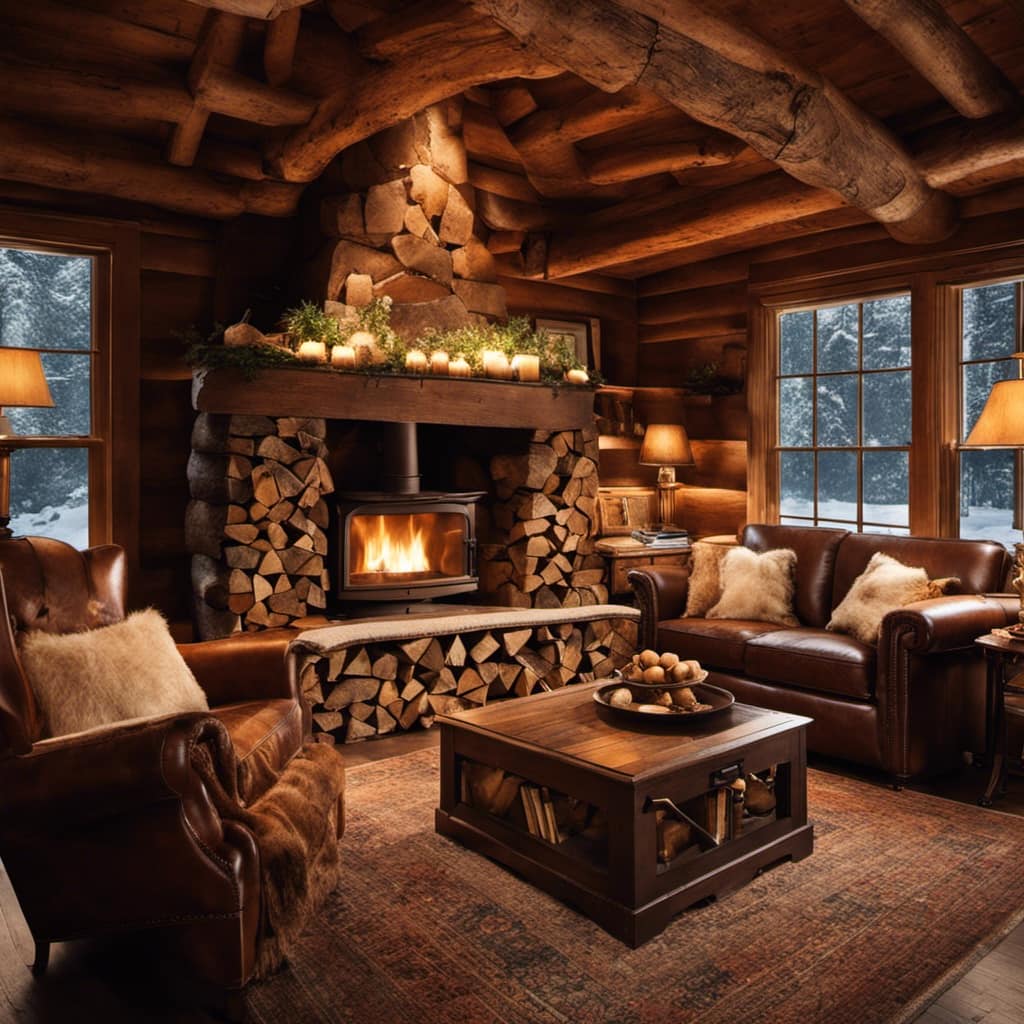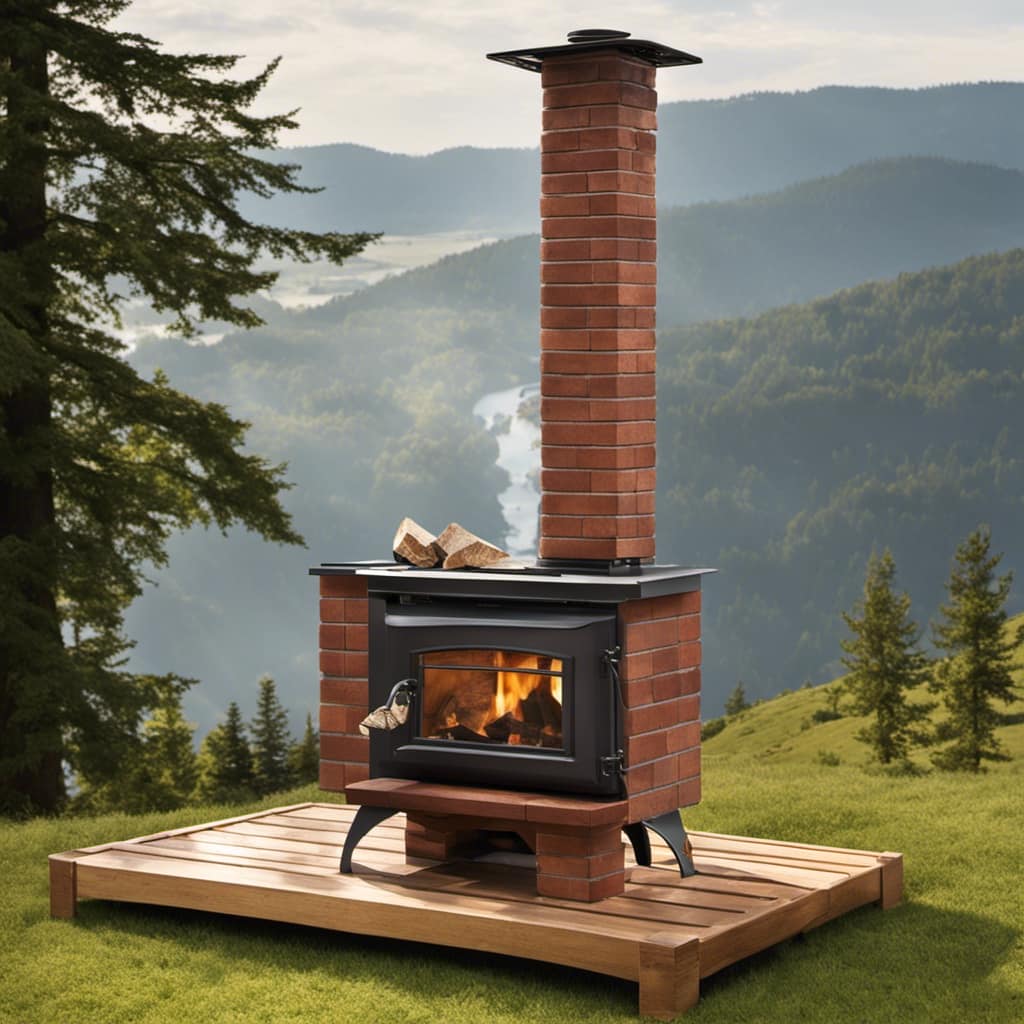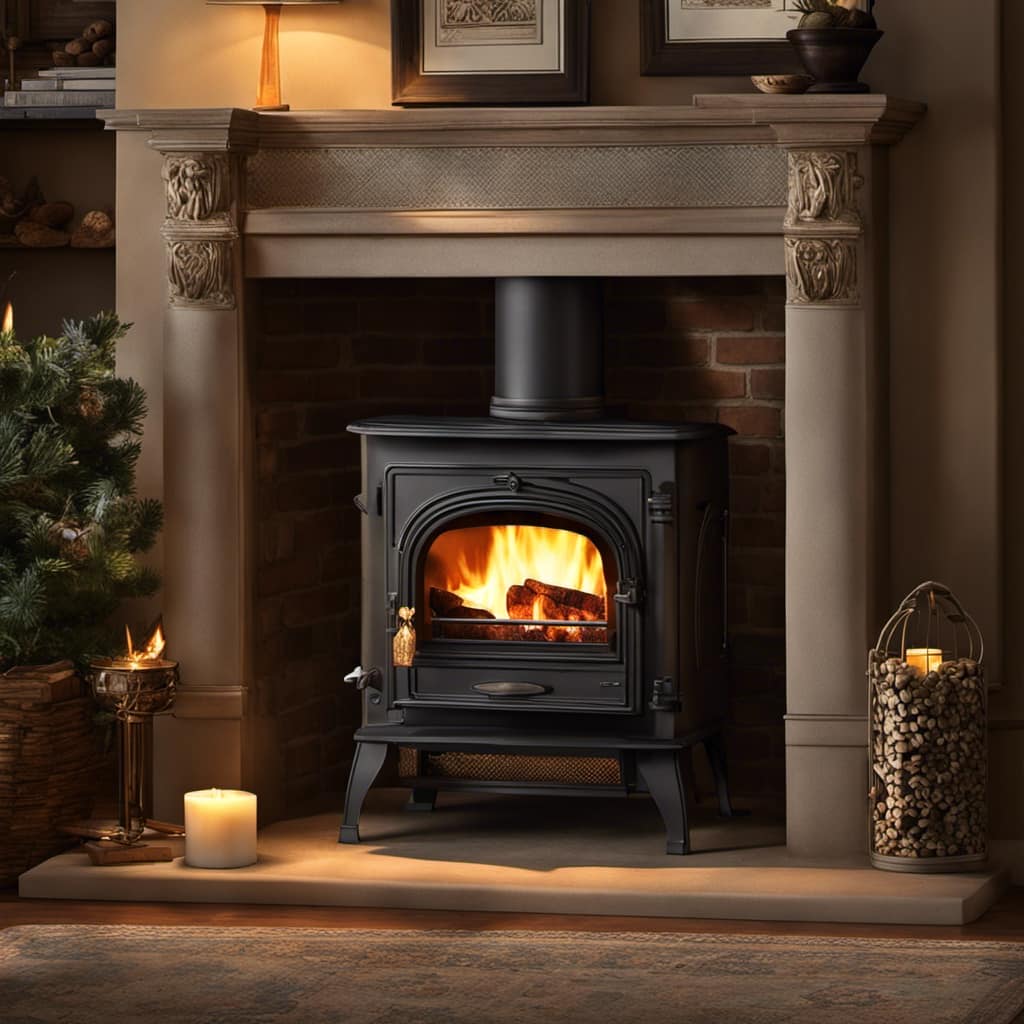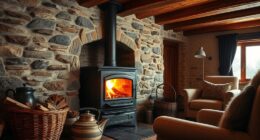
While I methodically arrange the logs in my wood stove, I highly appreciate the straightforward yet important method that guarantees effective burning and consistent warmth.
In this article, I will guide you through the steps of stacking wood in your wood stove, from selecting the right wood to maximizing airflow.
With these practical tips, you’ll be able to create a well-organized stack that keeps your fire burning bright and your home cozy throughout the winter.
Key Takeaways
- Seasoned wood burns more efficiently and produces less smoke.
- Striking a balance between hardwoods and softwoods is important for optimal heat.
- Properly prepared wood ensures efficient burning and maximum heat output.
- Proper stacking technique promotes efficient burning and heat production.
Choosing the Right Wood for Your Stove
I find it important to choose the right wood for my stove to ensure efficient and clean burning.

When it comes to choosing the right wood for your wood stove, there are a few factors to consider.
One of the first decisions you’ll need to make is whether to use seasoned or green wood. Seasoned wood has been dried for at least six months, which makes it burn more efficiently and produce less smoke. Green wood, on the other hand, is freshly cut and contains a higher moisture content, resulting in less heat output and more creosote buildup in your stove.
Another important factor to consider is the type of wood you’re using, specifically hardwood versus softwood. Hardwoods like oak, maple, and birch burn longer and hotter, providing more sustained heat for your stove. Softwoods like pine and fir, on the other hand, burn faster and produce more flames, but they don’t last as long. It’s important to strike a balance between the two, using hardwoods for longer burns and softwoods for quick bursts of heat.
Preparing Your Wood for Stacking
Before stacking the wood in the stove, I always make sure to properly prepare it. One crucial aspect of wood preparation is checking its moisture levels. Wood with high moisture content is harder to ignite and produces less heat, so it’s important to ensure that the wood is properly seasoned. Ideally, the moisture content should be around 20% or lower. To achieve this, I use a moisture meter to measure the moisture levels before stacking.

Another important step is splitting the wood into smaller pieces. This not only helps with proper airflow and combustion but also makes it easier to stack and arrange the wood in the stove. By splitting the wood, I ensure that it burns efficiently and provides maximum heat output.
Now that we’ve properly prepared the wood, let’s move on to the next step: the proper technique for stacking wood.
The Proper Technique for Stacking Wood
To ensure a stable and efficient arrangement, I start by stacking the larger pieces of firewood at the bottom of the storage area. This provides a solid foundation for the rest of the stack. As I continue stacking, I make sure to alternate the direction of the wood, creating air gaps for better airflow. This helps the firewood burn more efficiently and produce more heat. It is important to leave some space between the logs to allow for proper circulation of air. Additionally, I avoid stacking the wood too high as it may cause instability. Here is a table that summarizes the benefits of using a wood stove and common mistakes to avoid when stacking wood in a stove:
| Benefits of using a wood stove | Common Mistakes to Avoid when stacking wood in a stove |
|---|---|
| 1. Cost-effective heating | 1. Stacking wood too tightly |
| 2. Environmentally friendly | 2. Stacking wood too high |
| 3. Provides a cozy ambiance | 3. Not allowing for proper airflow |
| 4. Can be used for cooking | 4. Using wet or unseasoned wood |
| 5. Reduces reliance on fossil fuels | 5. Ignoring safety precautions |
Maximizing Airflow for Efficient Burning
Maximizing airflow is crucial for ensuring efficient burning and a consistent heat output in my wood stove. Proper ventilation is important because it allows the fire to breathe, promoting a cleaner and hotter burn.

When stacking wood, there are common mistakes to avoid in order to achieve optimal airflow.
One mistake is stacking the wood too tightly. This restricts the airflow and makes it difficult for the fire to receive enough oxygen.
Another mistake is stacking the wood too close to the stove’s walls. This can block the airflow and prevent the heat from circulating properly.
It’s also important to avoid stacking the wood too high, as this can cause the top layers to collapse and block the airflow.

Maintaining and Tending to Your Wood Stove
Maintaining and tending to my wood stove involves regular cleaning and inspection to ensure its proper functioning. Cleaning the wood stove is essential to prevent the buildup of creosote and other debris that can lead to chimney fires. I make sure to remove ashes and soot from the firebox and clean the glass door to maintain a clear view of the fire. Additionally, I inspect the stove for any signs of damage or wear, such as cracks in the bricks or rust on the metal parts. Troubleshooting common wood stove problems is also part of my routine. By referring to the table below, I can quickly identify and address issues such as poor draft, insufficient heat, or excessive smoke. Regular maintenance and troubleshooting help me keep my wood stove running efficiently and safely.
| Common Wood Stove Problems | Possible Causes | Solutions |
|---|---|---|
| Poor Draft | Blocked chimney | Clear chimney of obstructions |
| Damaged gasket | Replace gasket | |
| Inadequate air supply | Open air vents fully | |
| Insufficient Heat | Wet or green wood | Use dry, seasoned wood |
| Restricted airflow | Check and clean air vents | |
| Damaged baffle or firebricks | Repair or replace damaged parts | |
| Excessive Smoke | Cold or wet wood | Use dry, seasoned wood |
| Closed damper or air vents | Open damper and air vents | |
| Damaged chimney liner | Repair or replace chimney liner |
Frequently Asked Questions
How Long Should I Season My Firewood Before Stacking It in the Wood Stove?
Before stacking firewood in the wood stove, it is important to season it properly. I recommend seasoning for at least 6-12 months to reduce moisture content. This ensures efficient burning and avoids excess smoke and creosote buildup.
Can I Stack Different Types of Wood Together in the Stove?
Yes, you can mix different types of firewood when stacking it in the wood stove. However, it’s important to consider the burn characteristics and moisture content of each wood type for optimal efficiency.
Should I Stack the Wood Loosely or Tightly in the Stove?
I prefer to stack my wood tightly in the stove. It helps to maintain a steady burn and ensures efficient use of fuel. However, some people prefer loosely stacked wood for easier ignition and better airflow. Ultimately, it’s important to find what works best for your specific stove.

How Often Should I Clean the Ashes From the Wood Stove?
I clean the ashes from the wood stove every few days to maintain proper airflow. I use a metal scoop to transfer the ashes into a metal bucket, then dispose of them outside away from flammable materials.
Is It Safe to Leave the Wood Stove Unattended While It Is Burning?
Yes, it is not safe to leave the wood stove unattended while it’s burning. Always supervise the fire and make sure to properly extinguish it before leaving. Follow the manufacturer’s instructions for safe operation and maintenance.
Conclusion
In conclusion, stacking wood in your wood stove isn’t just a chore, but a way to ensure efficient and effective burning.
By choosing the right wood, preparing it properly, and using the correct stacking technique, you can maximize airflow and get the most out of your stove.

Remember, a well-stacked fire can warm both your body and your soul, turning your home into a cozy sanctuary on those cold winter nights.
So grab your logs, get stacking, and let the warmth embrace you.
Growing up surrounded by the vast beauty of nature, Sierra was always drawn to the call of the wild. While others sought the comfort of the familiar, she ventured out, embracing the unpredictable and finding stories in the heartbeat of nature.
At the epicenter of every remarkable venture lies a dynamic team—a fusion of diverse talents, visions, and passions. The essence of Best Small Wood Stoves is crafted and refined by such a trio: Sierra, Logan, and Terra. Their collective expertise has transformed the platform into a leading authority on small wood stoves, radiating warmth and knowledge in equal measure.










